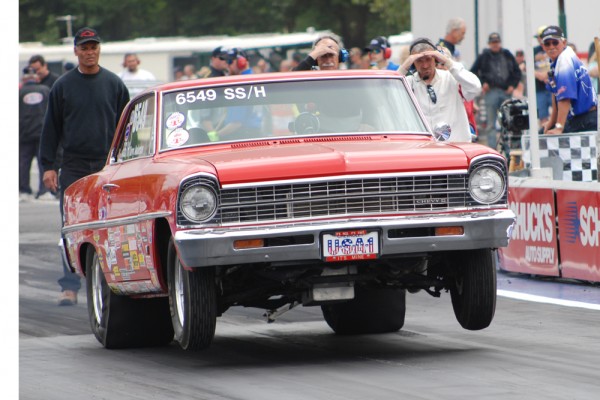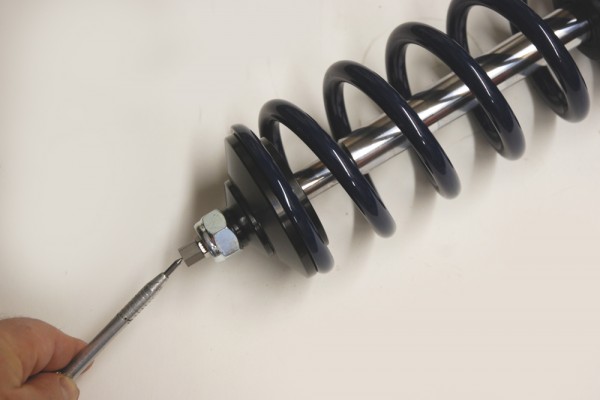Adjustable shock absorbers are becoming popular in drag racing. You can adjust their damping characteristics to suit varying tracks and/or track conditions to eliminate wheel hop and tire shake. That leads to improved reaction times. The best adjustable shocks are the ones that offer both compression and extension adjustment. These are better known as double-adjustable shocks.
To better understand how double-adjustable shocks can help you win more races, let’s take a look at how compression and extension affect a suspension.
Extension, or rebound, is the shock’s resistance to being pulled apart. From a drag racing perspective, extension can be used to control chassis separation—the point where the rear axle housing is pushed away from the chassis—at launch. Forces at launch push the car up and forward while the axle housing is being pushed down, planting the tires to the track. Those forces are also causing the rear slicks to distort, or wrap up.
Too much chassis separation can cause wheel hop and tire shake as the tires “unwrap” and try to return to their original form. A stiffer rear shock extension setting on a well-prepped track can provide quicker vehicle reaction times by controlling wheel hop and tire shake. A “bald” or poorly prepped starting line will mandate a softer shock extension setting so more downward force is applied to the tires so they’ll hook up.
Compression, or bump, is the shock’s resistance to the chassis moving downward or the rear axle housing moving upward or into the chassis. Compression adjustment is critical since it determines how long the tires stay glued to the track after launch.
“A good starting point for rear shock adjustment is to set the rebound (extension) adjustment tight and the bump (compression) adjuster loose,” race chassis builder Jerry Bickel said. “Remember that the final setting that is best for your car must be found with some thoughtful trial and error and may change with track conditions.”
Here are some guidelines for setting up double-adjustable shocks:
1. Determine which pair of shocks to adjust first. If the car wheelstands excessively or bounces on the gear change, adjust the front shocks first. If the car rattles the rear tires, wheel hops, or has way too much body separation, adjust the rear shocks first.
2. When adjusting front shocks, the idea is to get a smooth transition in the car’s front end movement from launch through the first gear change. Bouncing and jerking motions don’t help the launch and will hurt elapsed times. If the car is violent on the launch and physically jerks the front wheels off the ground, the shock extension setting is too soft or loose. Be careful—if you go too stiff on the extension setting, the front won’t move upward sufficiently to transfer weight and the car will bounce on the tires after the launch.
If the car bounces on the gear change, the shock compression needs to be stiffer. When the car bounces on the gear change, it’s coming down on the front suspension travel limiter and then bouncing back up again.
3. When adjusting the rear shocks, the idea is to force the rear tires onto the track surface as hard as possible (track conditions permitting). Keep in mind the shocks are what actually control how much force or “hit” you’re applying to the tires. If the shocks are too loose on the extension, you might get way too much rear body separation. If the shocks are too stiff, the car will flatten the tire excessively or simply spin them.
Making an adjustment on most double-adjustable shocks is as easy as turning a dial. Using Strange Engineering’s shocks as an example, compression is changed by adjusting the marked knob from 1 (full counterclockwise) to 12 (full clockwise). The extension adjuster is extremely sensitive to change; one click will make a significant change. Note that the compression and extension dials can be in different places on the shock body. On the Strange Engineering strut shown in the photos, the compression adjuster is on the bottom and the extension adjustment is at the top. Adjusting other brand shocks is essentially similar to the procedure we used for our Strange struts and shocks in the captioned photos.








Very good info,, I’ve improved my cars et from this info,. I do have an issue that literally no one has addressed on any of the boards or at my local chassis shop,. After installing a set of santhuff springs and 90/10 shocks. My chevelle front travel has gone crazy!! As I get on the converter to stage the front of car shoots north like someone inflates an air bag under the car, I’ve adj rear brakes with adj proportioning valve,, was considering Viking adj shocks but.. Not sure if that’ll help. Any info would be greatly appreciated
I forgot to imply,, this is before I launch.. Before!!
What you’re experiencing is what some old time drag racers saw in the sixties and early seventies. Back then it wasn’t uncommon to drill a hole in a set of shocks and drain the oil, or to simply replace the front shocks with a set of leaking old junk yard jobs. On a similar note, it was also pretty common to swap the springs for the smallest wire diameter springs you could find (usually from a no option 6-cylinder car). When you got on the brakes on the starting line (prior to the leave), the nose would rise.
There’s more: Almost all replacement drag race (only) front springs are wound with a thinner wire and have more coils. When first installed they tend to have a higher-than-normal ride height, but then they settle (often a lot). Aside from that, when you hit the throttle, the nose will rise quickly, particularly when you have a really loose front shock absorber.
By the description I’m guessing the front end of the car has the upper a-arm bushings replaced with some loosey-goosey low friction jobs. That would also allow for rapid front-end movement. With this setup, the way to control front-end rise is by way of the shock absorber. I’m pretty sure part of your problem is a set of too-loose shocks or perhaps the 90/10’s are simply worn out.
Finally, I don’t know how fast your car is, but with quicker examples, some form of front-end limiter will likely be required. The limiters (some are cable, some use a-arm stops) simply limit the amount the front end of the car actually rises during the launch. Summit Racing stocks Competition Engineering cable style limiters, (part number CEE-2025) or Competition Engineering bolt on style limiters (CEE-2026). I’ve used the bolt on format before and they work perfectly.
Bottom line? Replace the shocks and add some travel limiters. I’m pretty sure you’ll get some ET.
Im just now getting your reply, I’m looking all over the net and found my question,, thanks for the reply,. But yes I have travel limiters on it,, the shocks are Calvert 90./ 10, new,. And they extend very easily,, Car runs 680s in the 1/8 over the last year I’ve been leaving at only 2200rpm to keep front down as I stall up., Still can’t believe I found my old post ,,wished I’d got some kind of notice of your response,, but looks like I’ll be buying a set of double adj shock’s
Oh yea,, yes the front a arms are very loose , with the springs out there’s no resistance on bushings,. I kinda did a little work tho accomplish this,. But yes it’s friction free
wish i could afford something like this. thank you for the valuable info my friend.